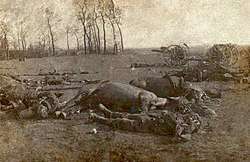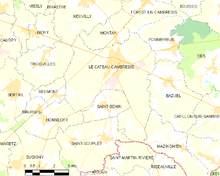Battle of Le Cateau
The Battle of Le Cateau was fought on the Western Front during the First World War on 26 August 1914. The British Expeditionary Force (BEF) and the French Fifth Army had retreated after their defeats at the Battle of Charleroi (21–23 August) and the Battle of Mons (23 August). The British II Corps fought a delaying action at Le Cateau to slow the German pursuit. Most of the BEF was able to continue its retreat to Saint-Quentin.
| Battle of Le Cateau | |||||||
|---|---|---|---|---|---|---|---|
| Part of the Great Retreat on the Western Front of the First World War | |||||||
 British dead at the Battle of Le Cateau. | |||||||
| |||||||
| Belligerents | |||||||
|
|
| ||||||
| Commanders and leaders | |||||||
|
|
| ||||||
| Units involved | |||||||
|
|
| ||||||
| Strength | |||||||
|
23 infantry battalions 18 cavalry regiments (9 at half strength) 6 divisional cavalry squadrons 162 guns (27 batteries) 84 machine-guns |
40 infantry battalions 12 cavalry regiments 2 divisional cavalry squadrons 246 guns (41 batteries) c. 80 machine-guns | ||||||
| Casualties and losses | |||||||
| 2,900 |
7,812 (700 killed, 2,600 captured) 38 guns | ||||||
Battle
On the morning of 26 August, the Germans arrived and attacked II Corps (General Sir Horace Smith-Dorrien). Unlike the Battle of Mons, where the majority of casualties inflicted by the British were from rifle fire, Le Cateau was an artilleryman's battle, demonstrating the devastating results which modern quick-firing artillery using shrapnel shells could have on infantry advancing in the open.[1] The British deployed their artillery about 50–200 metres (55–219 yd) behind the infantry, while the German artillery used indirect fire from concealed positions.[2] With the guns so close to the infantry, the British had unintentionally increased the effectiveness of the German artillery-fire, because shells aimed at the British infantry could just as easily hit the British guns.[3]

The British 5th Division was on the right flank, on the southern side of the Le Cateau–Cambrai road between Inchy and Le Cateau. The 3rd Division was in the centre, between Caudry and Inchy and the 4th Division was on the left flank, on the north bank of the Warnelle. The road was sunken in places, providing inadequate long-range firing positions and in many places the Germans could close up to the British positions unobserved. On the right flank, west of Le Cateau, the Germans marched along the road from the north to Le Cateau. The British were on a forward slope and suffered many casualties during the withdrawal.[4]
At 03:30, Smith-Dorrien decided to "strike the enemy hard and after he had done so, continue the retreat" but the purpose of the operation was unclear to his subordinates. A "hold at all costs" mentality was evident in the 5th Division on the British right flank. The commander of the 2nd Battalion, King's Own Yorkshire Light Infantry, was given a written order that "There will now be NO retirement for the fighting troops; fill up your trenches, with water, food and ammunition as far as you can". The order was confirmed by a colonel from the II Corps staff.[5] The delaying action never occurred because the order to defend arrived at the front line at about the same time as the Germans, in some places later. Nor were the conditions of a doctrinal delay observed, such as refusing to let British units be pinned down. Smith-Dorrien did not choose positions with adequate fields-of-fire and with prepared and hidden routes of withdrawal.[5]
According to Der Weltkrieg, the German official history, Lieutenant-General Sixt von Armin, the commander of IV Corps, issued an order at 11:15 that co-ordinated the encounter battle but there is no evidence of German command above the divisional level. 75 per cent of the troops of IV Corps were in contact before they received the order and the rest never made it to the battlefield. Armin had no authority over II Cavalry Corps, which fought independently.[5]
Holding their ground despite many casualties, the British right and then the left flank began to collapse around noon. The arrival of the Corps de cavalerie Sordet (French Cavalry Corps, General André Sordet) provided a shield for the British left flank and enabled the British to slip away, despite German attempts to infiltrate and outflank them.[6]
That night, the Allies withdrew to Saint-Quentin. Of the 40,000 British troops who fought at Le Cateau, 7,812 became casualties, 2,600 being taken prisoner.[7] Thirty-eight guns were abandoned, most having their breech blocks removed and sights disabled by the gun crews.[8]
Aftermath

II Corps retreated on the morning of 27 August and in two days of marching, broke contact with the Germans.[5] Having lost 7,000 men and another 2,500–3,000 footsore and exhausted men who had to be evacuated to Le Mans to recuperate, II Corps was not battleworthy for at least two days.[5] Although credited at the time by Field Marshal Sir John French for having saved the BEF, he later criticised Smith-Dorrien.[9] German losses were 2,900.[10]
The Germans were pleased with their victory. The historian of Infantry Regiment 93 wrote
The battle of Beaumont-Inchy will always be one of the most glorious days in the history of the regiment, which demonstrated that in a frontal attack against an enemy that was heretofore considered unbeatable, the crack troops of the British Army, the 93rd was not merely their equal, it was superior." 75th Field Artillery Regiment said that the battle "strengthened the self-confidence of the German troops … all the more so because the British army was made up almost exclusively of long-service active army troops, who were superbly trained and equipped.
— Historian, IR 93[5]
German satisfaction in part arose from a mistaken belief that they had defeated the BEF, not II Corps and a cavalry brigade. It was this mistake which allowed II Corps to retire as German troops were given a night of rest instead of being sent to pursue the British forces.[11]
A second battle of Le Cateau took place in much the same area from 5 to 11 October 1918.[12] The Allies captured the St. Quentin-Cambrai railway, 12,000 prisoners and 250 guns, but suffered 536 casualties.[13]
See also
- Retreat from Mons
- La Ferté-sous-Jouarre memorial
- Le Cateau
Footnotes
- Edmonds 1926, pp. 141–160.
- Bailey 2004, pp. 212–213.
- Zuber 2011, p. 235.
- Zuber 2011, p. 215.
- Zuber 2011.
- Edmonds 1926, pp. 161–174; Humphries & Maker 2013, pp. 259–265.
- Edmonds 1926, p. 182.
- Edmonds 1926, pp. 176–187.
- Beckett & Corvi 2006, p. 200; Humphries & Maker 2013, pp. 260–261.
- Zuber 2011, p. 257.
- Gardner 2003, p. 60.
- "Chapter XVI. — The Second Battle of Le Cateau — and the Battle of the Selle". nzetc.victoria.ac.nz. Retrieved 14 January 2018.
- "Chapter XIV. — The Second Battle of Le Cateau". nzetc.victoria.ac.nz. Retrieved 14 January 2018.
References
- Bailey, J. B. A. (2004). Field Artillery and Firepower. Annapolis, MD: Naval Institute Press. ISBN 978-1-59114-029-0.
- Beckett, Ian F. W.; Corvi, Steven J. (2006). Haig's Generals. Barnsley: Pen & Sword Military. ISBN 978-1-84415-169-1.
- Edmonds, J. E. (1926). Military Operations France and Belgium, 1914: Mons, the Retreat to the Seine, the Marne and the Aisne August–October 1914. History of the Great War Based on Official Documents by Direction of the Historical Section of the Committee of Imperial Defence. II (2nd ed.). London: Macmillan. OCLC 58962523.
- Gardner, Nikolas (2003). Trial by Fire: Command and the British Expeditionary Force in 1914. Contributions in Military Studies. Westport, CT: Praeger. ISBN 978-0-313-32473-4.
- Humphries, M. O.; Maker, J. (2013). Der Weltkrieg: 1914, The Battle of the Frontiers and Pursuit to the Marne. Germany's Western Front: Translations From the German Official History of the Great War. I. Part 1. Waterloo, Canada: Wilfrid Laurier University Press. ISBN 978-1-55458-373-7.
- Zuber, Terence (2011) [2010]. The Mons Myth. Stroud, Gloucestershire: The History Press. ISBN 978-0-7524-7628-5.
Further reading
- Battle of Le Cateau 26th August, 1914. Tour of the Battlefield (Naval & Military Press repr. ed.). London: HMSO by Command of the Army Council. 2005 [1934]. ISBN 978-1-84574-033-7.
- Becke, Major A. F. (2006) [1919]. The Royal Regiment of Artillery at Le Cateau, Wednesday, 26th August 1914 (Naval & Military Press reprint ed.). Woolwich: Royal Artillery Inst. Print. House. ISBN 978-1-84342-545-8.
- Bird, Antony (2008). Gentlemen, We Will Stand and Fight: Le Cateau 1914. Ramsbury: The Crowood Press. ISBN 978-1-84797-062-6.
- Brown, Malcolm (1993). The Imperial War Museum book of the Western Front. London: Sidgwick and Jackson. ISBN 978-0-283-06140-0.
- Cave, Nigel; Sheldon, Jack (2008). Le Cateau. Battlefield Europe. Barnsley: Pen & Sword Books. ISBN 978-0-85052-842-8.
- Evans, M. M. (2004). Battles of World War I. Devizes: Select Editions. ISBN 978-1-84193-226-2.
- Gavaghan, Michael (1999). Illustrated Pocket Guide to Mons, 1914. Forgotten Battles. Leyland: M & L. ISBN 978-0-9524464-5-3.
- Gavaghan, Michael (2000). Illustrated Pocket Guide to Le Cateau, 1914. Forgotten Battles. Preston: M & L. ISBN 978-0-9524464-6-0.
- Jones, Nigel H. (1983). The War Walk: A Journey Along the Western Front. London: Robert Hale. ISBN 978-0-7090-1174-3.
- Lomas, David (1997). Mons – 1914. Oxford: Osprey. ISBN 978-1-84176-142-8.
External links
| Wikimedia Commons has media related to Battle of Le Cateau. |